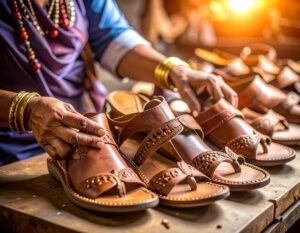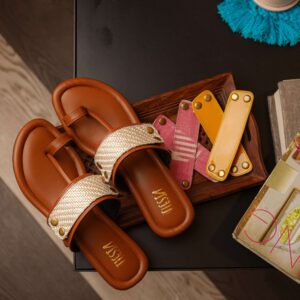Ethnic footwear holds a charm that transcends trends—each pair tells a story of history, craftsmanship, and culture. Among the many iconic traditional Indian footwear styles, Kolhapuri chappals and Bantu chappals stand out as the ultimate symbols of heritage fashion.
Both are known for their handmade leather craftsmanship, intricate detailing, and cultural significance. Whether you’re dressing up for a wedding, festival, or just looking to elevate your casual ethnic look, these chappals can add flair to your outfit. But the question remains: which one is truly the king of ethnic fashion?
Let’s dive into their origins, craftsmanship, comfort, and style versatility to help you choose the perfect pair for your wardrobe.
- The Rich Heritage Behind Kolhapuri & Bantu Chappals
Kolhapuri Chappals: A Legacy of Royals & Artisans
The Kolhapuri chappal is more than just footwear; it’s a piece of Indian history. Originating from the Kolhapur district of Maharashtra, these handmade leather chappals have been worn for centuries by warriors, royals, and common folk alike. Built for durability and comfort, Kolhapuris were a symbol of nobility and elegance.
Some of the most popular varieties include:
1. Kapshi Kolhapuri – Known for its minimalistic design and sturdy build.
2. Maharaji Chappal – A regal option with intricate detailing.
3. Sinkeshwari Kolhapuri – A fusion of modern designs with traditional craftsmanship.
4. Kurundwadi Kolhapuri – Famous for its unique leather weave and heavy-duty sole.
5. These chappals represent the epitome of Indian craftsmanship, blending art and functionality seamlessly.
6. Bantu Chappals: The Lesser-Known Treasure of Traditional Footwear
7. While Bantu chappals may not have the same widespread recognition as Kolhapuris, they boast an equally rich legacy. These handcrafted sandals feature premium leather and often showcase detailed carving, embroidery, and bold designs. Bantu chappals are perfect for those who appreciate artistic craftsmanship and a modern twist on traditional footwear.
8. Popular varieties of Bantu chappals include:
Jali Bantu – Known for its intricate cut-out designs.
Chakla Bantu – Structured with bold leatherwork.
Khekda Bantu – Adorned with metallic studs and embellishments, making them a standout piece.
For those who love a bold, artistic touch, Bantu chappals are a fantastic choice.
- Aesthetics & Design: Which One Stands Out?
Kolhapuri Chappals: The Minimalist’s Dream
Kolhapuris are known for their earthy tones, handwoven leather straps, and timeless elegance. These sandals are perfect for anyone who loves a classic look with traditional undertones. Kolhapuris are typically designed with simple, clean lines that complement a variety of ethnic outfits, from kurta-pajamas to sarees and even Indo-western attire.
Bantu Chappals: A Work of Art
Bantu chappals are a bolder, more structured design. Adorned with embroidery, metal embellishments, and intricate stitching, these sandals are perfect for those who love to make a statement. If you prefer footwear that doubles as a work of art, Bantu chappals are your go-to.
- Comfort & Durability: Which One Feels Better?
Kolhapuris: Built to Adapt to Your Feet
Crafted from premium leather, Kolhapuris become softer and more comfortable over time, molding to the shape of your feet. With no nails used in their construction, Kolhapuris ensure a smooth and comfortable fit, ideal for long-term wear. Their flexibility increases with use, making them perfect for those seeking comfort with every step.
Bantu Chappals: Sturdy & Fashion-Forward
Bantu chappals typically feature a more structured sole, providing excellent support. Some designs include cushioned insoles for added comfort, offering a firm and supportive fit. If you prefer immediate structure and firm support, Bantu chappals are an ideal choice.
Both styles are highly durable, with Kolhapuris offering long-term comfort and Bantu chappals providing instant support.
- Versatility: Where Can You Wear Them?
Kolhapuris: The Ultimate Ethnic Staple
These chappals are perfect for:
1. Weddings (ideal wedding shoes for grooms and guests)
2. Haldi ceremonies (Haldi Kolhapuri chappals for a traditional look)
3. Cultural events and festivals
4. Casual everyday wear with kurta-pajamas, sarees, or Indo-western outfits
5. Kolhapuris are the ultimate traditional footwear for any ethnic occasion.
6. Bantu Chappals: Perfect for Modern Ethnic Fashion
7. Bantu chappals shine in:
8. Fusion outfits, blending modern and traditional styles
9. Semi-formal ethnic gatherings
10. Casual occasions where you want to stand out
11. Everyday wear for those who love artistic, handcrafted footwear
If you’re looking for a more fashion-forward look, Bantu chappals are the perfect addition to your wardrobe.
- Why You Need Both in Your Wardrobe
While Kolhapuris are a timeless classic, Bantu chappals add a modern, artistic edge to ethnic footwear. Instead of choosing one, why not have both?
For traditional weddings & festivals → Pick a beautifully crafted Kolhapuri chappal.
For Indo-western or fusion outfits → A detailed Bantu sandal will make you stand out.
For daily wear → Opt for a lightweight Kapshi Kolhapuri or Chamda slipper.
For statement looks → Go for a Chakla Bantu or Jali Bantu chappal.
Both styles carry a legacy of Indian craftsmanship and are worthy investments in your fashion journey.
Final Thoughts: Which One Wins?
Rather than viewing it as a competition, Kolhapuri chappals and Bantu chappals each offer unique attributes that make them indispensable in ethnic fashion. Whether you prefer the classic elegance of Kolhapuris or the bold, artistic flair of Bantu chappals, both are excellent additions to your footwear collection.
So, the real question isn’t which is better—it’s which one fits your style best.
If you’re ready to add authentic, handmade leather chappals to your collection, explore SelectU for the finest selection of Kolhapuri footwear, Bantu sandals, and handcrafted leather slippers.
“Step into tradition, embrace style, and walk with confidence! “




